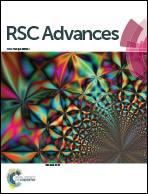Heterotheca inuloides (Mexican arnica) metabolites protect Caenorhabditis elegans from oxidative damage and inhibit nitric oxide production†
Abstract
The accumulation of reactive oxygen and nitrogen species (RONS) leads to oxidative stress, which triggers the onset of various pathological conditions. Appropriate copper chelators and nitric oxide (NO) scavengers represent novel strategies for preventing free radical damage. In this work, we tested a series of compounds derived from Heterotheca inuloides (Mexican arnica), including natural products, semisynthetic derivatives, and an acetone extract of the plant, for their ability to protect Caenorhabditis elegans under stressful conditions. Specifically, we tested their ability to bind copper (Cu2+), and inhibit nitric oxide (NO) production in RAW 264.7 macrophages activated with lipopolysaccharides (LPS). The results revealed that several compounds and the acetone extract of H. inuloides exhibited excellent potential for increasing the resistance of C. elegans to stressful conditions induced by copper and juglone. We examined the formation of copper(II) complexes with UV-Vis, ESR, and ESI-MS spectroscopy. We found that quercetin (3,3′,4′,5,7-pentahydroxyflavone) could bind to Cu2+. In contrast, natural and semisynthetic cadinene-type compounds showed no ability to bind to copper or protect C. elegans. Additionally, flavonoids isolated from the acetone extract of H. inuloides could inhibit NO production, but cadinane-type compounds showed little or no inhibitory activity.


 Please wait while we load your content...
Please wait while we load your content...